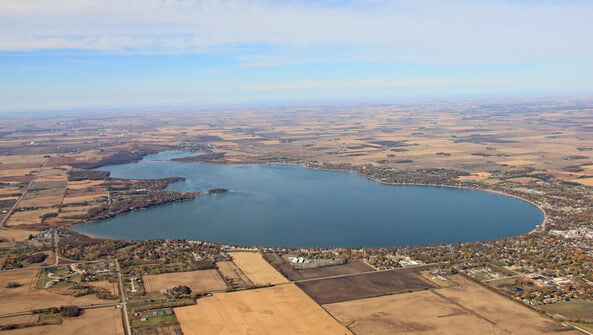photocredit: clearproject.net
BY: RACHEL WUMKES
Many years ago, before I lived in beautiful Clear Lake, I used to come up from Des Moines to visit. Back then, Clear Lake wasn’t nearly as wonderful as it is today. While I wanted to enjoy a cooling dip in the lake on a hot day, I just couldn’t get past the murky, slimy green water.
Thankfully, a group of citizens banded together to make a change, creating the CLEAR project. For the past several years, the CLEAR project has worked diligently with the DNR and the community to clean up years of damage done by soil and nutrient pollution. Now, our lake is once again living up to its “clear” name as we’ve seen the return of vegetation, and becoming host to one of the Midwest’s premier fishing lakes.
Now days, I have no problem jumping in to Clear Lake. The smell is gone, the water is cleaner, and it has become an overall fun experience to be on or in the water.
So why, then, have I read so many disparaging things about our lake this summer? It seems a surplus of the bacteria E.coli has festered for much of the summer around McIntosh Beach, resulting in a media onslaught. All of a sudden, people come out from the woodwork, hiding behind the protection of their computer screen, to blast Clear Lake.
I, for one, found it a bit disheartening to see how quickly people jumped on the bandwagon of “this lake is dirty – don’t swim in it!” and simply ran with that notion. Folks… things like that can be extremely detrimental to the livelihood of our town. And while you may think tourism doesn’t affect you directly… I assure you, it most certainly does.
So how about we have some facts today? A lesson on Clear Lake, E.Coli and all that it entails.
Jim Sholly heads up the CLEAR Project here in Clear Lake, and holds a plethora of knowledge on just the subject. Here’s what he had to say about McIntosh:
“Readings have been high at this beach for several reasons, all working in conjunction. The physical shape and location of the beach on the shoreline keeps it very well protected from the normal winds this time of year. It is also surrounded by beautiful bull rush beds, as well as significant submerged vegetation out front. All of these things combine to greatly limit the amount of mixing and circulation of the water between the beach area and the surrounding lake to bring in fresh water. It’s almost like the perfect storm for the bacteria. E.coli in Clear Lake, as with most lakes in Iowa, is almost exclusively sourced from pet and wildlife waste being washed into the lake by rain events. McIntosh beach has a large goose population as it is a quieter beach than those on the main side of the lake (City Beach and State Park), leading to a significant loading of waste to be washed into the lake. All of these elements make it easier for E.Coli to live in the water, but when combined, it makes it almost impossible for the sunlight to penetrate into the water enough to kill off the bacteria. Thus, a perfect storm for E.Coli to fester.”
Now… this pertains to McIntosh Beach, not the rest of the Lake. And before you get excited… yes, the E.Coli advisories are limited to that area, and that area only! Because E.coli is so volatile, its population can be isolated to specific areas with conditions that favor it. The popularity and high use of the beaches on the main lake keep wildlife populations away. There are also ordinances in place to keep pets away from those areas, thus limiting their waste at the beach. Because of how clear our water is now a days, any E.coli at those beaches dies within hours of being washed into the lake.
Now… that being said. Clear Lake is still just that – a lake! After a rain shower, it’s maybe not the best time to go from a swim. The water has been stirred up and the sunlight cannot get into the water to burn off the bacteria that may have run off from the land into the water.
As for the concern for the rest of the lake (City and State Beach) Jim stated, “Water samples are taken on Clear Lake every Tuesday afternoon or Wednesday morning by DNR staff and taken to the Iowa Hygienics Lab for processing. They sample McIntosh and Clear Lake State Park beaches each week. Clear Lake City Beach is not sampled but will have levels very close to whatever State Park is testing at. Those results are made available to the CLEAR Project, and available online every Friday morning. They are a snapshot of the E.coli levels at the moment they are sampled. E.coli is an extremely sensitive bacteria that dies easily when exposed to sunlight. Levels spike after a rain event that brings in waste and sediment to muck of the waters. As the water clears up and sunlight reaches deep into the water, the bacteria quickly begins to die off.”
So there you have it, folks. A brief history about the state of our beloved Clear Lake. As with any body of water, you need to understand that there will be an ebb and flow of cleanliness and well-being. Unfortunately, we are not in control of the weather patterns and cannot change the amount of run-off and animal waste that sometimes enters the lake.
We can, however, continue to support the CLEAR Project and all they do to ensure we have the best possible body of water for our town. If you’re interested in learning more, I encourage you to attend their event. On Sunday August 11th at 5pm at PM Park is the Association for the Preservation of Clear Lake (APCL’s) annual picnic. Anyone is invited to attend to learn about the APCL and efforts to protect the lake. Cash bar is available and dinner will be served at 5:30 for $13. The keynote speaker after dinner is Dr. John Downing who authored the original research that kicked off the lake restoration efforts and the CLEAR Project. His talk is generating lots of buzz and will be well worth the price of admission.
See you at the Lake!

